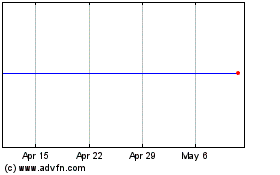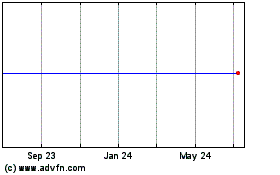CEO takes aim at Microsoft's Teams, a competing product in
office collaboration
By Sarah E. Needleman
This article is being republished as part of our daily
reproduction of WSJ.com articles that also appeared in the U.S.
print edition of The Wall Street Journal (September 6, 2019).
Competition is heating up between Microsoft Corp. and its
smaller rival Slack Technologies Inc., as the companies battle in
the market for providing software that helps workers communicate
and complete a range of office tasks.
After Slack's first earnings report since its public-market
debut, the company's chief executive shared anecdotes about large
customers that he said pay for Microsoft's broad-ranging Office 365
software, yet still use Slack as their primary collaboration tool
rather than the tech giant's competing product, called Teams.
"They still chose Slack, because only Slack was capable of
meeting their needs," Stewart Butterfield, the San Francisco
company's chief executive and co-founder, told analysts
Wednesday.
Slack and Teams both allow workers to send messages, documents
and images to individuals or groups, as well as engage in
videoconferencing. They also are integrated with other software to
help users execute a range of tasks, from employee training to
tracking sales data.
Slack was founded 10 years ago as a game company before pivoting
to enterprise software in 2014. It made its public-market debut in
June.
Microsoft launched Teams in 2017 as a free chat-based workspace
in Office 365, its software suite that includes programs such as
Word and Excel, though it can be accessed independently as well. In
July it said that Teams had more than 13 million daily users, with
some analysts questioning whether the battle with Slack was already
won. That is because Slack said in January it had 10 million daily
users, and it hasn't publicly updated that figure.
Microsoft and Slack, in addition to Cisco Systems Inc. with its
Webex product, and the Workplace collaboration tool from Facebook
Inc., are competing for a slice of the growing
enterprise-application software market. Microsoft Chief Executive
Satya Nadella has said the company is learning more about how Teams
can be used with each client signed up.
"It's the communications tool. It's the collaboration tool. It's
the line-of-business tool for meetings as well as business
process," Mr. Nadella told analysts during a July conference
call.
Microsoft declined to comment Thursday on Slack's CEO's
remarks.
On its earnings call Wednesday, Slack touted a new feature
called Shared Channels, with executives describing it as the most
important addition to the platform to date. Due to roll out widely
later this month, it allows customers to collaborate with people
outside their organization while meeting compliance rules. Mr.
Butterfield said greater than 20% of Slack's more than 100,000 paid
customers have opted to test the feature, exceeding internal
expectations.
Being able to attract more paying customers is critical to
Slack, which unlike Microsoft isn't buffered by other business
units. The majority of Slack's customers use a free version of the
tool, but on Wednesday the company touted having 720 customers who
each account for at least $100,000 in annual recurring revenue in
the July quarter, up from 645 in the prior three-month period.
Slack's share price fell as much as 17% in extended trading
Wednesday after the company warned that revenue growth in the
current quarter wouldn't be as strong as in recent ones. Slack also
forecast wider-than-expected losses in the current period, casting
a pall on the stock despite the company beating second-quarter
estimates on revenue and raising its full-year revenue outlook.
Those losses moderated Thursday, with the stock closing off
3.4%. Some industry analysts said investors overreacted, arguing
that deceleration should be expected for a hypergrowth company like
Slack. KeyBanc analyst Brent Bracelin said Slack's market
opportunity is still huge, even with Microsoft being involved.
"It's not a winner-takes-all market," Mr. Bracelin said. "This
is a really, really large space."
However, a study last year from Spiceworks, a marketplace that
connects tech buyers and sellers, forecast Microsoft Teams would
record stronger customer growth than Slack over the next two years
because it comes free with Office 365, which offers ubiquitous
programs such as Word and Excel.
World-wide spending on collaboration software is expected to
rise to $16.5 billion this year and eventually reach more than
$26.6 billion in 2023, according to research firm International
Data Corp.
Mr. Bracelin said Slack has an advantage over Microsoft in
helping businesses get more productivity out of workers by
automating and streamlining routine tasks. Slack offers users more
than 1,800 third-party applications that work on top of its
software, compared with just a few hundred for Teams.
Slack's user-engagement numbers are another sign of strength,
D.A. Davidson & Co. analyst Rishi Jaluria said. People spend an
average of 90 minutes daily using its software, Slack said, far
more than the average time spent with some popular consumer
applications such as Facebook and the mobile game "Candy Crush
Saga."
Videogame publisher Activision Blizzard Inc. said people spent
an average of 38 minutes each day playing its "Candy Crush" games
in the first quarter. Facebook users also are logged on for an
average of 38 minutes a day, eMarketer said in April.
"Engagement is a key metric because if people are using your
software and getting value out of it, they will continue to do so
for the foreseeable future," Mr. Jaluria said.
Write to Sarah E. Needleman at sarah.needleman@wsj.com
(END) Dow Jones Newswires
September 06, 2019 02:47 ET (06:47 GMT)
Copyright (c) 2019 Dow Jones & Company, Inc.
Slack Technologies (NYSE:WORK)
Historical Stock Chart
From May 2024 to Jun 2024

Slack Technologies (NYSE:WORK)
Historical Stock Chart
From Jun 2023 to Jun 2024
